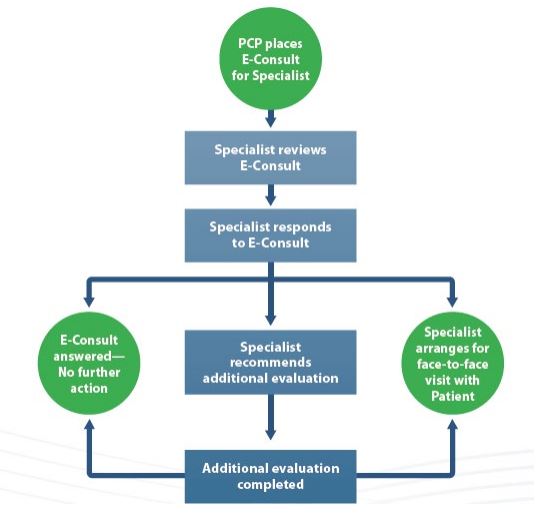“Improving our understanding of clinician-level perceptions regarding e-consultation is important for informing program implementation and adoption, and ensuring that e-consults facilitate delivery of high-quality care. Prior evaluations demonstrated that primary care clinicians and specialists believe that e-consults may improve communication between clinicians. Primary care clinicians and specialists across several health care systems have reported that use of e-consultations increases the efficiency of care and reduces appointment burden for patients.
[..] In a 2018 study, primary care clinicians working in safety-net clinics described e-consultations as “increased administrative burden, broadened clinical responsibility, and restructuring of specialty care delivery.” A perception among primary care clinicians that e-consultation increases their workload may hinder adoption and lead to negative outcomes among the primary care workforce. The aim of this study was to explore perceptions regarding the association between e-consultations and workload among a national sample of VHA primary care clinicians.
[..] Primary care clinicians with at least 300 total patient encounters, including at least one e-consultation, between July 2016 and June 2017 were eligible for inclusion. Sites with fewer than 500 total visits, fewer than 3 specialties, or without any e-consultation visits were excluded. We enrolled a national sample of primary care clinicians because of the potential for variations in the implementation of e-consultations at the local level, and because this process was implemented across many clinical settings that likely differ with respect to their organizational climate. We sampled clinicians using a stratified purposeful strategy based on (1) clinician use of e-consultations (frequency, high or low), (2) facility use of e-consultations (frequency, high or low), (3) clinic location (Veteran Affairs Medical Center [VAMC] or community-based outpatient clinic [CBOC]), and (4) medical training (doctor vs nurse practitioner or physician assistant).

[..] Of the 34 primary care clinicians enrolled working across 27 VHA clinical sites, 9 (26%) were between the ages of 40-49 years; 23 (68%) were female (Table). We identified 3 themes regarding the association between e-consultation and workload among primary care clinicians, including (1) the process of entering, tracking, and following up on e-consultations added time burden to primary care clinicians; (2) primary care clinicians perceived that e-consultation shifts diagnostic and follow-up responsibilities from specialists to themselves; and (3) e-consultations improve the timeliness and quality of care provided despite the perceived increase in workload.
Full article, Lee M, Leonard C, Greene P et al. JAMA Network Open 2020.10.30